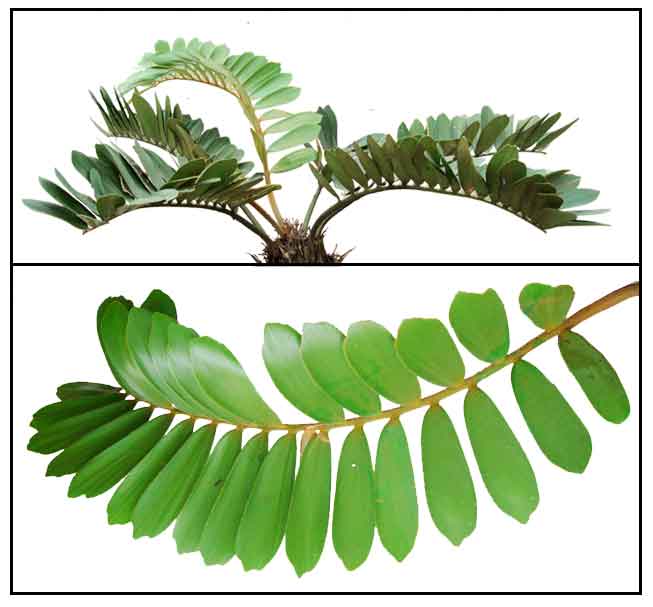| 
Botany
Zamia is a perennial palm-like dioecious plant
with simple, sometimes branched, short trunk. Leaves are pinnately compound,
crowded on the terminal part of the trunk, up to 1.5 meters long, with a
prickly stalk. Leaflets are 10-15 on each side of the rachis, opposite
or alternate, oblanceolate, overlapping. Male cones are cylindrical, up to 10 centimeters long,
often clustered; female ones are shorter and elongate-ovoid.
Distribution
Recently introduced.
Constituents
Yields the toxic glucoside cycasin,
found in ten genera of living cycads.
Toxin is present in the roots, seeds and foliage.
Properties
- Toxicity. (See Studies and Toxicity below)
Parts utilized
Rhizomes, roots, fruit.
Uses
Edibility
- See Toxicity / Caution below.
- The starchy stems, after treatment to remove the poisonous principle, were a significant part of aboriginal diets.
- Washed roots contain 38% starch and 6% protein,
used to make "sofkee," a staple of the traditional Seminole Indian diet
and a component in the diet of many indigenous peoples. (1)
Folkloric
- Purely ornamental, without
any known folkloric use in the Philippines.
- In folk medicine elsewhere, fruit used in therapeutic shampoos.
- Gum from the stem used for skin ulcers.
- Roots chewed for cough and believed to improve the singing voice.
- Dried powder placed inside socks and shoes to prevent athlete's foot
by decrease moisture.
Others
• Extracted starch from root is marketed as "arrowroot"
as ingredients to biscuits baby food, chocolate, spaghetti. Also used
in cooking as a thickener. (1)
Toxicity / Caution
!
• Cycad palms produce three toxins: cycasin, beta-methylamino-L-alanine and an unidentified toxin.
• Cycasin content is a known toxic glucoside, present in 10 living
cycad genera.
• Cycasin has shown to be a strong mutagen.
• Toxic to cattle and sheep. In cattle, causes "wobbles"
characterized by a weird stance and stumbling gait.
• In humans and livestock, consumption of inadequately detoxified roots or seeds results in two syndromes: a short-onset digestive upset with severe continuous vomiting followed by diarrhea, and a more severe syndrome associated with depression and gradually developing irreversible neurological paralysis. In humans, the symptoms may resemble those of ALS (amyotrophic lateral sclerosis). (1)
Studies
• Toxic Properties / Cycasin: The toxic glucoside cycasin is found ubiquitously and exclusively in the 10 general of living cycads and is present in root, seeds and foliage. In the GIT, cycasin loses a glucose molecule to become the physiologically active methylazoxymethanol. The toxin must be removed from the roots and seeds by grating and washing before it becomes safe for human consumption. Acute consumption of cycasin in humans and animals can produce liver damage. Chronic exposure of experimental animals produces tumors in various body sites. Studies have shown it to be a very strong mutagen. Chronic long-term low-level exposure can cause permanent CNS damage. Beta-N-methyl-alpha-B-diaminoprorionic acid, the neurotoxic compound believed to cause neurological symptoms in man, has been isolated from seeds. (1)
Availability
Ornamental cultivation.
|





